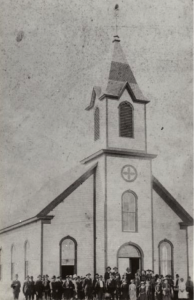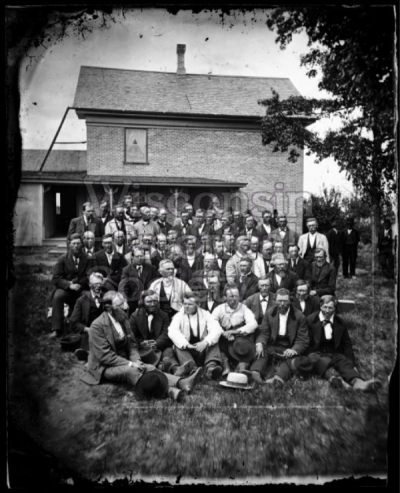
When Norwegian immigrants like Kristian Magelssen came to Wisconsin in the 1860s, they found an incredibly active Norwegian Lutheran Church. Comprised of fourteen distinct synods often divided by theology, these institutions provided a foundational compass for constructing and maintaining a sense Norwegian American cultural identity.[1]
19th century Norwegian communities in Wisconsin were sometimes home to Lutheran parochial schools as well, which offered both men and women a role as educators.[2] Children were provided a high-quality education grounded in theology, taught in Norwegian. Religious services were also held in Norwegian. Visitors to Trempealeau County could attend services in Norwegian into the 1940s.[3]
Food has also served as a vital conduit through which the Lutheran Church connects congregations to Norwegian ethnic identity. Since Norwegian American women were not historically provided the same degrees of equality in congressional membership (often membership was reserved for men), dinners, weddings, and other community functions offered a social outlet that persists today. Churches throughout Wisconsin, such as Stoughton’s Christ Lutheran Church, continue this connection between faith and food, hosting annual dinners featuring Norwegian ethnic foods like lefse and lutefisk.[4]

Written by Jared Lee Schmidt.
FOOTNOTES
[1] April R. Schultz, Ethnicity on Parade: Inventing the Norwegian American Through Celebration (Amherst: University of Massachusetts Press, 1994).
[2] Lori Ann Lahlum, “Women, Work, and Community in Rural Norwegian America, 1840-1920,” in Norwegian American Women: Migration, Communities, and Identities, edited by Betty A. Bergland and Lori Ann Lahlum (St. Paul: Minnesota Historical Society Press, 2011), 94; Antje Petty, “Immigrant Languages and Education: Wisconsin’s German Schools,” in Wisconsin Talks: Linguistic Diversity in the Badger State, edited by Thomas Purnell, Eric Ramy, and Joseph Salmons (Madison: The University of Wisconsin Press, 2013) 55 (note 5), 56 (note 6).
[3] Jane Marie Pederson, Between Memory and Reality: Family and Community in Rural Wisconsin, 1870-1970. (Madison: The University of Wisconsin Press, 1992), 36.
[4] Christ Lutheran Church, “Home,” Accessed: March 15, 2018, http://www.clcstoughton.org/; Eric Dregni, Vikings in the Attic: In Search of Nordic America (Minneapolis: University of Minnesota Press, 2011); Einar Haugen, “Norway in America: The Hidden Heritage,” in Makers of an American Immigrant Legacy: Essays in Honor of Kenneth O. Bjork, edited by Odd S. Lovoll (Northfield: The Norwegian-American Historical Association, 1980), 15-28; Lahlum, “Women, Work, and Community,” 96.